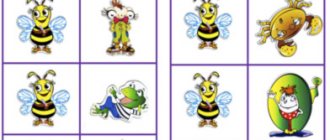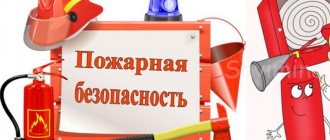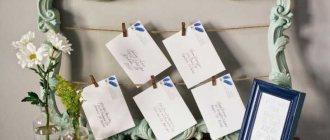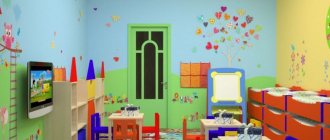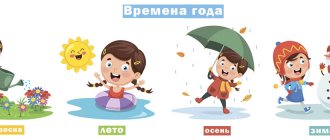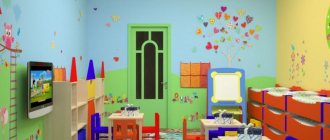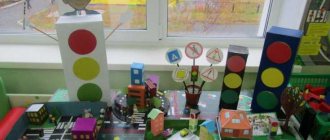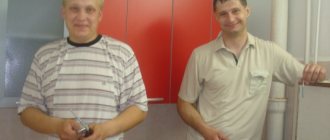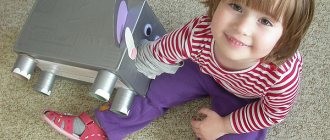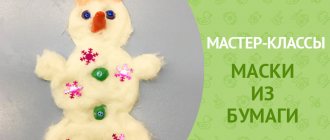What teaching aids can you make yourself for kindergarten?
Language development is not an isolated skill. To a large extent, it is determined by the general level of development of the child and, in particular, his intelligence.
Didactic manual on speech development
Activities that improve sensory and fine motor skills in children are of great importance in this process. For this, it is important to use teaching aids, a significant part of which can be made independently.
Children's learning, especially in junior and middle groups, should take place in a playful environment, otherwise they will lose interest in the subject and time will be wasted. For teaching to be effective, the teacher needs to use all available means to maintain the child’s useful activity.
Didactic materials for sensory development
The “Flower Petals” manual looks like this. A circle is attached perpendicularly to the straight stem. The edges of the central part are covered with Velcro. Several petals with images of objects or fairy-tale characters are offered. This fabric is also attached to the inner edge of each of them. The task is to find the petals with the corresponding words based on the letter drawn on the mug and attach them to the central part.
The game “Blow out the insects into the clearing” is designed to develop speech breathing. For this purpose, the “Polyanka” manual is used. It is a low box with high sides. Small cardboards with images of animals are suspended on short threads from the outside. The child must blow them out, but does not have the right to puff out his cheeks.
Important! In this way he is taught how to breathe correctly during a conversation.
The game "Clothespins" is made using the same manual. For this, the kids are given several colored clothespins and asked to build a fence. They place them on the edges, while loudly calling out the color used.
There are two horizontal lines of Velcro glued to the outer wall of the Polyanka manual. Each row contains four cards with images of animals, fairy-tale characters or objects. The child is told that in each row one of the pictures is extra and is asked to remove it. Then he should tell what the remaining images have in common and why.
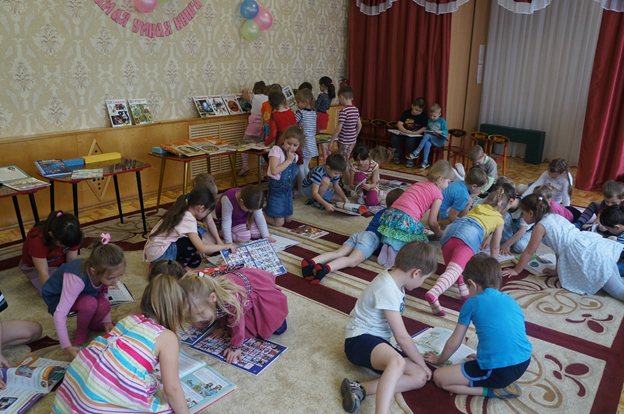
Lesson with children
Iconic didactic materials
One of these multifunctional aids is “Teremok”. It is a fabric house attached to a flat, solid base. It has a large number of pockets sewn into it, in which various pictures are placed. They can depict objects of the surrounding world, fairy-tale characters from the fairy tale of the same name, images of letters or syllables.
Consultation for parents on speech development of children 3-4 years old
There are various ways to use this manual in kindergarten.
Here's one of them. Children are shown pictures taken from a pocket attached to the tower. They ask what fairy tale this hero, who is depicted on the card, came from. The child must remember the name of the fairy tale and try to retell its content.
Important! If the child needs the help of a speech therapist, then it is provided. During the story, the teacher asks the child simple leading questions.
You can also use this manual in a preschool educational institution as follows:
- The teacher takes out cards showing the inhabitants of the tower, but does not show them. He depicts the sounds these animals make. The child must repeat them and name the hero of the fairy tale who is depicted on the card.
- The manual can be used to study prepositions that show the relative position of cards. The teacher places cards with pictures of animals in various pockets and asks questions about who is located where. The child must answer using the prepositions “above,” “under,” or “between.”
- Then the child is asked to formulate questions using the mentioned prepositions and ask them to the teacher.
Another task is the following:
- The child is given cards with images of fairy tale characters and asked to place them in various pockets.
- After this, the kid must say which animal lives on which floor and who is to the left, right, above or below him.
Master class on making a teaching aid “Logocube”
ELENA KOSENOK
Master class on creating a didactic manual “Logocube”
The didactic manual can be used in the form of game tasks, depending on the goals and objectives, it is also possible to change the game tasks. Children enjoy learning with this manual.
I present to your attention the production of a manual with clean articles.
The main task of pure sentences is to teach children to clearly pronounce sounds.
Options for games with pure clauses:
Option 1 The child, turning the cube, pronounces pure words. You can pronounce pure sentences with different intonation, timbre, quietly - loudly, slowly - quickly.
Option 2. Finish pure speech. The speech therapist pronounces the beginning of the sentence, and the child looks for an image with a suitable ending and completes the sentence.
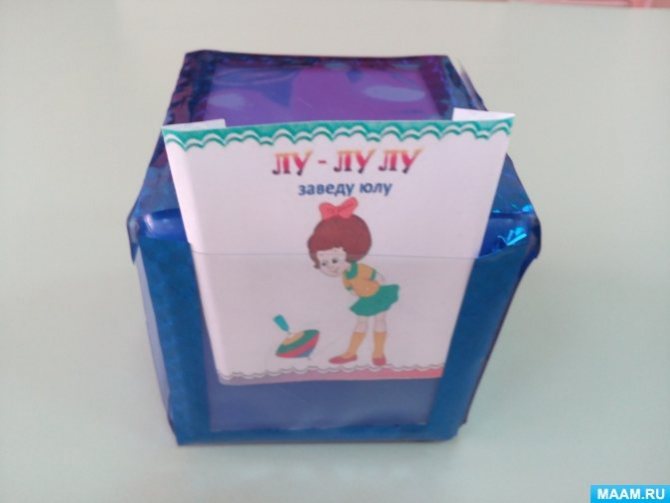
To make instructions you need:
plastic or book cover;
pictures with suggestions.
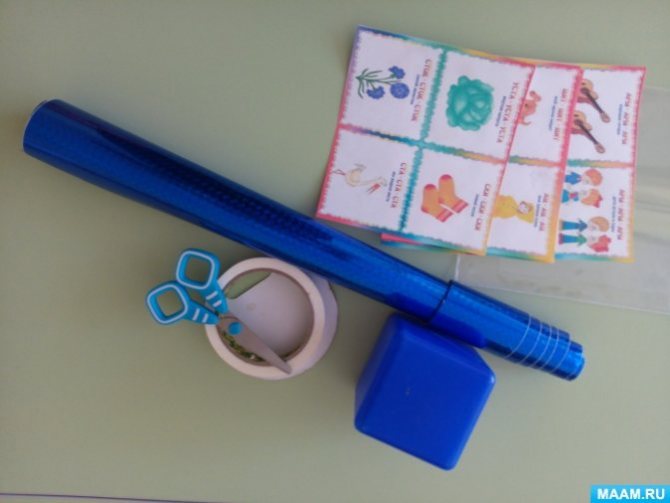
Take a hexagonal cube and apply strips of double-sided tape to each side on three sides.
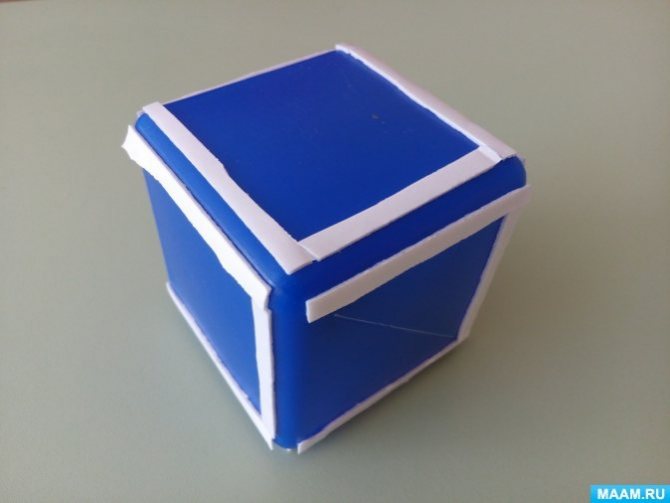
Then we cut out pockets measuring 7 * 7cm from plastic and glue them on each side of the cube.
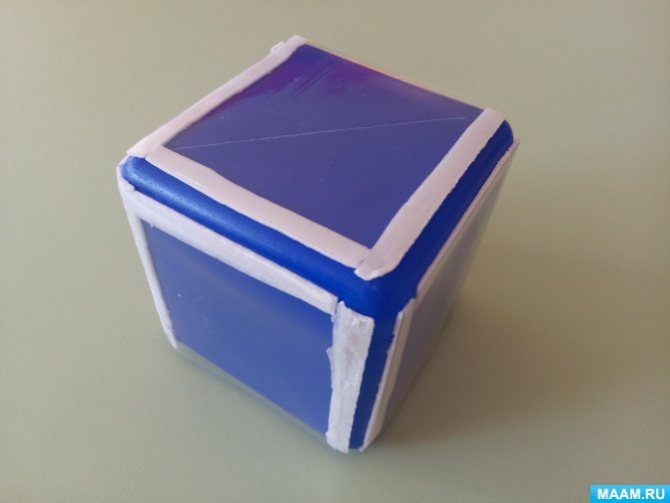
We take “self-adhesive” paper, cut strips 1 cm wide and glue them to the sides of the cube on three sides.
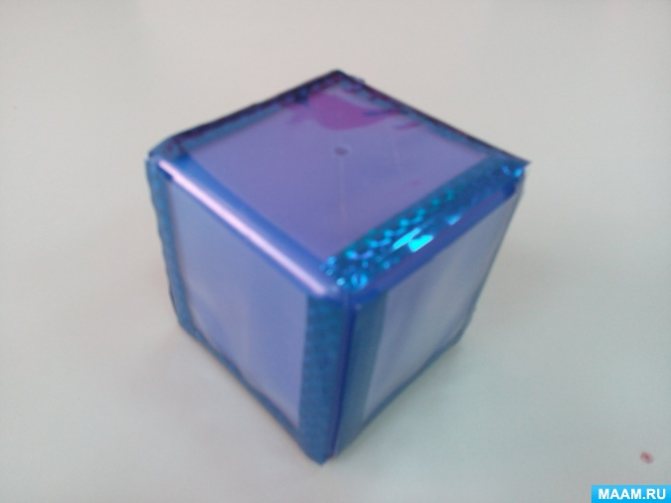
We put pictures with phrases in our pockets and play.
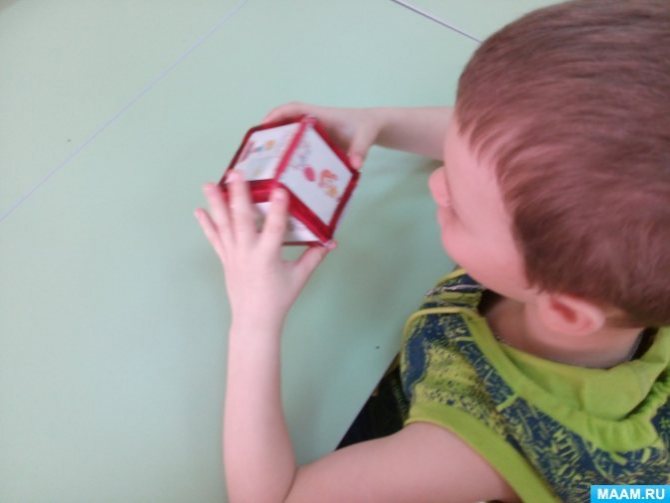
Master class “Using the speech therapist “Logocube” in the work of a speech therapist” I would like to share with my colleagues how I use the speech therapy manual “Logocube”. The instructions are a cube with 6 faces of different colors. Workshop on creating a teaching aid “The Tree of Seasons” from waste material. Many teachers use the “Seasons” teaching tree in their work. Using a tutorial like this helps improve your productivity. Master class on creating an educational visual aid “Funny Figures” Mathematics is a very complex science for preschoolers, so you should not miss a single approach that makes it more accessible. An approach that allows. Master class on creating a teaching aid “Autumn Gifts” for preschoolers. This manual was created for the purpose of cognitive development in children's ideas about the gifts of autumn (vegetables, fruits, mushrooms, classification of fruits and vegetables. Master) of the class on creating a didactic manual "Geochronological life of the Earth" Watching the children of my preparatory group, I noticed a genuine interest in the ancient history of the Earth. Children play with pleasure. Ecology for children “Natural zones of Russia” Preschoolers begin to learn about the world around them: with all the laws of nature, with the diversity of animals and plants. And big. Master class on creating manual didactics for MDI by the author of “Musical Christmas Tree” Good afternoon, dear colleagues!, and also not. Master class on making a teaching aid on MDI "today where the bee hid the honey! "Dear Colleagues! I present to your attention a master class on preparing MDI “Guess where the bee hid the honey?” (For children 3-5 years old).
By the way: what is the best way to pump up your biceps to make them grow?
Master class on creating a speech therapy aid “Rotik” Hello! I present to your attention a master class on making a speech therapist “ROTIK”, which I came up with, sewed and already made. Master class on creating a teaching aid “Tree of Seasons” To create a tree you will need: • Printed templates from the collection of pictures “Tree of Seasons” on maam.ru • Scissors • Double-sided.
One source
Where are teaching materials used?
The use of hand-made speech development aids for preschoolers creates a playful basis for working with them and determines the storyline of the lesson. A child, especially in the junior and middle groups of kindergarten, thinks concretely, using images, rather than abstract logical constructs. He can react to assignments received from a speech therapist or teacher, being a participant in a specific, albeit fictitious, situation. The teaching aids serve as the factual basis for their learning each year.
Speech development based on visual cues
When a child learns to express his thoughts, he must follow a certain pattern of expressing his thoughts. For a child who is almost unable to concentrate on one subject at his age, this is impossible. Using teaching aids in the form of cue cards helps build a story line. For younger children, we are talking about much simpler things. They simply have to name the objects or briefly describe the actions with the cue cards.
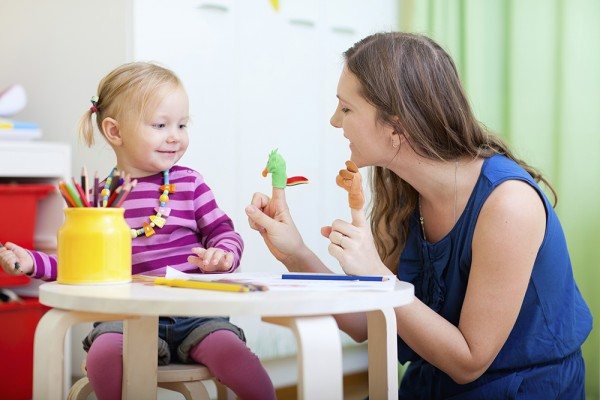
Speech therapist works with a child
For example, in the didactic manual “Zippers,” the child must choose among the open colored zippers lying on the table those that correspond to the teacher’s instructions and close them. At the same time, the child describes his choice, its reasons and the actions he takes.
At an older age, each visual cue can be used together with leading questions from the teacher and be the basis for a coherent story. This can be seen, for example, in classes devoted to professions.
What to do if a 5-year-old child speaks poorly
Every description of your actions, answer to a specific question, or short story based on visual cues helps your child better develop his speech skills. Serve as preparatory exercises for adult life.
Learning to retell
The development of coherent speech in children is one of the most important skills that a child must be taught. Without mastering it, he will not only not be able to develop properly intellectually, but also will not be able to fully socialize, not being able to conduct a dialogue or express his thoughts.
When retelling, the child must create a coherent, long story. However, for this he will need tips, which can be received during didactic games and from the teacher.
The development of fine motor skills plays an important role in this process.
Important! By engaging in retelling, you will be able to strengthen your speech and intellectual skills and increase the level of development of your personality.
Learning to think
Human speech is closely related to thinking. The same is true for a child. Communication is not limited to expressing your thoughts or describing actions. The level of speech proficiency is largely determined by the degree of development of the child’s personality and thinking.
Do-it-yourself teaching aids for kindergarten can be used not only for stories, but also as an excuse to ask your child questions about cause-and-effect relationships in the world around him. For example, using cards related to the plots of fairy tales, you can ask questions about the circumstances of the characters’ actions, the reasons and consequences of their actions.
You can combine the classes in question with the study of mathematics.
In addition, the educational function of speech development classes is important. For example, if a child is asked questions about the features and beneficial properties of the plants depicted in the pictures, then gradually this knowledge will be consolidated in the child. If additional questions are asked about this material, the child’s knowledge will become more detailed and practical.
Preparing for literacy
To do this, you need to learn not only oral speech, but also study letters and words. Children of senior preschool age, with the help of a teacher and parents, are able to master the alphabet and basic reading skills.
For this purpose, a do-it-yourself didactic manual on speech development for kindergarten with cards depicting letters, syllables or words can be used.
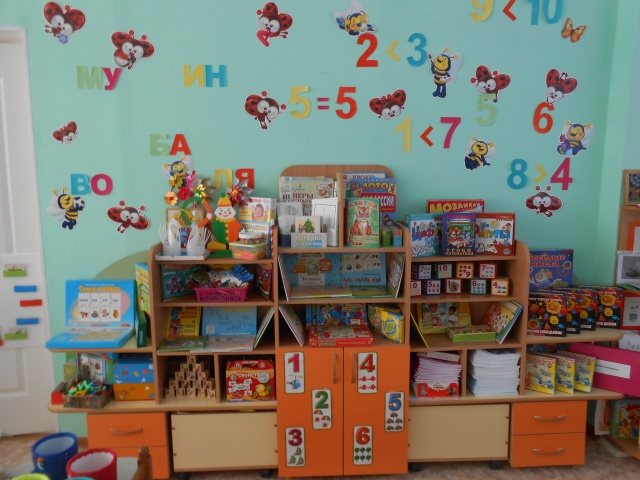
Picture 4 Speech corner
methodological manual “Speech - cubes”
| Author: Pisarevskaya Polina Sergeevna, Teacher speech therapist MBDOU "Child Development Center - g - kindergarten No. 15 “Wonderland” Khanty-Mansiysk |
Introduction
Didactic manual “Speech-cubes” for the correction of lexical and grammatical categories and related speech in children of senior preschool age. The use of game techniques when correcting speech with the help of a manual allows you to develop phrasal speech, master the construction of complex sentences, enrich your vocabulary (expressive speech), master the skills of word formation and inflection with the help of exercises and homework
The content of corrective work in accordance with the requirements of the Federal State of Preschool Education (hereinafter referred to as FGT) is aimed at creating a system of comprehensive assistance to children in mastering the basic educational program of preschool education, correction of disabilities and (o) mental development of schoolchildren, their social adaptation and provision of qualified assistance to children disabled people One of the priority tasks of older preschoolers is preparing children for school. One of the main indicators of a child’s readiness for successful learning is correct and developed speech. Good language is the most important condition for the full development of children. The richer and more correct a child’s speech, the easier it is for him to express his thoughts, the wider his opportunities for acquaintance with the surrounding reality, the more meaningful and complete relationships with peers and adults, the more active his mental development is. Therefore, it is so important to take care of the timely formation of children’s speech, its purity and correctness, preventing and correcting various violations that are considered deviations from the generally accepted norms of a given language.
Speech therapy, as a science, allows you to study speech disorders, prevent and overcome them in the process of raising and teaching a child directly in educational activities and play. For children who have problems with lexico-grammatical forms and related expressions, these are, as a rule, children from the group of general language underdevelopment. The manual preserves the meaning and role of play activities in preschool age and timely language correction, as a necessary condition for the comprehensive development of personality, communication culture and intelligence. Systematization of didactic games according to the manual helps to overcome language deficiencies and teaches to speak correctly and competently.
The purpose of the textbook “Speech - Cubes” is the development of lexical and grammatical categories and related speech in children of senior preschool age.
The objectives of the manual are revealed through games and exercises, both in fragments of direct educational activity and in individual work as a moment of surprise.
- Attracting interest, creating motivation for a child’s interaction with the language process: the “Mood” game.
- Development of skills through tactile sensations, word-symbol and object associations: playing with the “Sensory” cube.”
- Formation of the ability to coordinate a noun with adjectives, the game “Color the Picture”; possessive adjectives and the development of ideas about the world around us: a “lost” game.”
- Master the agreement of names with cardinal numbers in gender, number, and case. Game "Konta".
- Consolidating word formation skills, activating vocabulary, expanding ideas about the world around us. Game “Little Boy”.
- Consolidation of pronoun and noun in agreement, repetition of lexical arguments. "Greedy" game.
- Consolidation of the dictionary on a lexical topic. For example, the game "Seasons".
- Development of visual gnosis. Find a picture game
- Learn to fly an airplane; in space. Game "Catch a fly".
- Formation of skills in selecting antonyms: words - signs, words - actions. Game "On the contrary".
- Teaching the ability to compose a descriptive story using TRIZ technology in pedagogy. Games “Descriptive story”, “Write”
- Consolidation of the use of prepositions as part of sentences, related speech [1]
Tutorial series:
Box …… .. ……………………… .. …….…. 1 PC.,
Cubes……………………………………. …… 6 pcs.,
Card index………………………………….. 8 pcs.,
Images for tasks ………………………… 30 pcs.
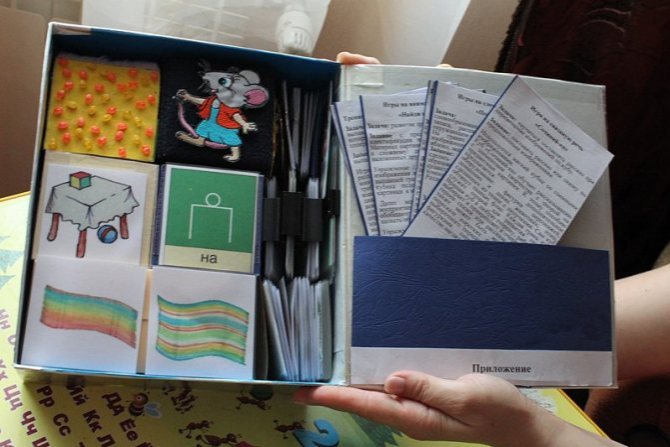
From history to reality
Creation of a teaching aid as a need to involve the child in the process of language correction, by changing the visual material. From a plate - a book, postcards, pictures, etc. to a three-dimensional object - for example, a cube. The wooden reading blocks that I saw in the store gave me the idea of using the cube as an option for correcting a child’s speech to help with proprietary speech therapy. For example, the logo technology of S.V. Konovalenko; E.O. Astafieva; O.S. Gomziak; THERE. Komarov; E.N. Spivak; T.A. Tkachenko at the stage of sound automation and correction of lexical and grammatical categories of speech. The simple and perfect shape of a cube is embodied in the Speech Cube teaching aid made from cellulose material, mica and other waste and office supplies.
The work has begun... The “Speech - Cube” manual is a series of six cubes measuring 7.5 / 7.5 cm. Drawing the sides of cubes, both permanent and with replaceable images, images. Cards with pictures can be used for game tasks and exercises. The combination of tasks is aimed at the formation of lexical and grammatical categories (formation and bending of words) and the development of coherent speech not in the form of individual sentences, but statements, descriptions, and reasoning. If we directly consider the purpose of each cube, its multifunctionality is reduced to a minimum, then the instructions are presented in a comprehensive manner, which makes it possible to fully conduct the correctional and educational process. The use of methods from the theory of inventive problem solving (TRIZ) in pedagogy makes it possible in practice to develop students’ coherent speech in games using developed diagrams and card symbols. Each symbol can be used in combination to assign exercises to other games. The essence of this method is that the child does not receive knowledge in a ready-made form, but during the game, through knowledge of only the symbol, he searches for a pattern that also meets the basic requirements of FGT. The principle of constructing lexical and grammatical categories of teaching linked speech according to the Speech-Cube manual from simple to complex with the use of both speech therapy technologies and psychological techniques to improve the quality of training and education. [3] app.docx (1.46 MB)
You can't teach a person to be happy
But you can teach him to be happy.
Makarenko A.S.
THE PRACTICE OF USING THIS INSTRUMENT “RECUBIC” SHOWS that the child is not distracted by the game lesson, but, on the contrary, is involved in the game. Focus your attention and interest on the exercise or task, choosing the answer yourself, fantasizing, thinking. The advantage is also good because children of any age can play it (the difficulty level of the tasks must correspond to the child’s speech skills) both individually and in a front-to-back classroom. [4]
Option 1. The child stands in the center of the circle with his eyes closed and holds a cube in his hand. Children walk in a circle saying:
One two three four five
Let's spin the cube!
Option 2. Children stand in a circle. The cube is moved along the chain, pronouncing any familiar rhyme. The child on whom the cube has settled chooses a face at will based on the task.
Option 3: The leading child walks in a circle and says a nursery rhyme. The child, by whom the count is being made, takes the cube, closes his eyes, rotates it, stopping on any face of the cube. The task is completed by yourself or all children together.
The concept of relevance, the child’s interest in a certain point in time forces us to search and create multifunctional and creative means that implement the tasks of the corrective educational process of learning and development of children in accordance with the requirements of the federal state of preschool education [5]
Game "Mood"
Competitive preparation
Task: to depict the hero’s mood on the fallen edge of the cube, to talk about the feelings that the hero experiences - feelings of empathy through facial expressions.
Task: transfer the facial expression of the fallen hero to the edge of the cube.
Playing with facial images of different moods allows for mini-diagnosis of problem areas and areas that require correction for further interaction within the team. Such diagnoses are often much more accurate and effective over time than diagnoses made using various tests and questionnaires. This training relieves tension between strangers by showing not what a person is thinking, but what facial expressions they are using. Plus, learning to interact while playing is safe, effective, and just plain fun and enjoyable.
Equipment: a cube with pockets on the edges, images of children's faces. [6]
Games for learning and declension of adjectives from nouns.
“Painting color”
Task: match the noun with relative adjectives
Task: Place blank image stencils along the colored edges of the cube and name the color image of the object. For example, red tomato, blue sky, golden square. Now let's complicate the task a little. Rotate the cube to match the counter ringtone and select the color of the cube's face. Task: name red fruits and vegetables or an object of any other color that falls on the upper part of the face (apple, pomegranate, radish, beet, tomato - red. Clouds - blue...) Well done!
Equipment: cube with colored borders, images with blank images [7]
Lost
Goal: to agree a possessive adjective with a noun.
Scene images with single elements of objects are used, parts of animals are used using two cubes with removable edges.
- Task: from the images on the faces of one cube, take the missing details on the faces of another. For example: whose turn is it? – fox tail, attach the fox tail to the image of the fox. Whose is it spinning? – car, replace the wheel with a picture of a car. Whose ears are these? – bunny ears, attach the ears to the image of the hare’s head.
- Task: a selection of images to identify trees and their leaves.
The version of the game can be organized according to the type of development: where the conversation continues with questions about the result of choosing a tree - leaf, for example: the name of the tree, the shape of the leaves, where it grows, if it changes color in the fall, etc.
Equipment: two cubes with pocket sides, pictures for the task. [8]
Word games
"Vice versa"
Goal: To develop the ability to select antonym words
The task of the game is performed on one cube and with the involvement of a second one, which is filled along the edges with antonym words highlighted.
Assignment: selecting words, antonyms for words - actions. For example: opens - closes, pours - pours, puts on - takes off, etc.;
– selection of antonyms for postcards according to schemes: what color? (black and white); what do we hear? (hot cold); What size? (big small); what do we hear? (in a quiet voice - in a loud voice); what do we see? (day - night) what does it taste like? (sour – sweet);
– selection of antonyms for the word – sign: wide – narrow, tied – loose, high – low, big – small
Equipment: two cubes with a point, pictures for the task. [nine]
“Scullion”
Objective: to consolidate word formation skills, activate vocabulary, expand ideas about the world around us.
Place images along the edges of the cube: beets, tomatoes, peach, apple, carrots, pear.
Task: determine what you can use to make juice or compote, then form adjectives from the noun, naming the juice or compote. Which would be superfluous for compote. Separate the concept of juice and compote. Equipment: cube with pockets, pictures with vegetables and fruits. [10]
"Greedy"
Task: agreement of pronouns with nouns, repetition of lexical arguments
An exercise to consolidate pronouns and nouns into agreement. Images are used on general topics: clothes, toys, fruits, etc. are located on the sides of the cube. Scrolling identifies the question by the image on the top edge of the cube. For example: whose topic..? - my; whose clothes are these..? - Maybe; whose toys? - my
Equipment: cube with pockets, images of clothes, shoes, toys...
Games on the chord and declension of a noun with a pronoun, with a numerator
"Count"
Task: to master the coordination of names with quantitative numbers in gender, number, case.
For counting, a cube with Arabic numerals and drums with images are used.
Task: an image with a selected number of objects in the image (the number on the face) is placed on each face to match the name with the numerator in gender, number, case. Very easy to play. The child, looking at the top edge of the cube, says: “I have two carrots.” Then he turns it over to the other side and passes it to the next one with the words “What about you?” - “I have five apples.”
Equipment: a cube with fixed edges depicting numbers, attaching a picture depicting numbers. [eleven]
Time orientation game on an airplane; in space.
“Catch a fly!”
Goal: learn to navigate an airplane; in space.
Spatial referencing problem. Ability to navigate on an airplane: image, sheet of paper with an image; paragraph; in space, consolidation of concepts at the top, bottom, right, left, center. Activity is determined by the direction of fall of the arrow or center position. The reference point (designation) depends on the age of the players or individual playing conditions. For example: one, two, three, four, five I need to catch a fly on... (position) we determine the direction along the edge, for example the arrow points up - to the ceiling and so on
Equipment: cube with pocket edges, direction indicators, arrows [12]
"Season"
Task: place pictures of the same season on a cube (with removable edges.
Identify an additional feature, for example: autumn, winter, spring, summer.
Exercise 1. Listen to the riddle, proverb, choose the solution from the picture on the cube. For example:
Prepare a sleigh... (in summer) and a cart... (in winter).
The fields are empty, the ground is wet, and it is raining heavily. When will this happen? (Autumn)
Who hits the roof all night, clapping, muttering, singing and calling a truce? (it's raining)
They fly without wings, they run without legs, they swim without sails (clouds).
They grow in the spring and fall off in the fall. (foliage)
Exercise 2. Selecting characteristics by month of the year. Spin the cube like you say a nursery rhyme: spin, spin, I mean...
Equipment: a cube with pockets on the edges, images of signs of the season. [13]
Games for attention and memory
"Find a photo"
Goal: development of visual gnosis
Comparison with images of objects, identification of visual images. The material of the images is selected from simple to complex - two, three silhouettes overlapping each other.
Exercise 1. Find and make a list of images of all the shapes along the contour on the left edge of the cube. Use the second cube to highlight color images of the object for each outline shape.
In addition, it is possible to expand the visual perception of image contours to generalizing topics: for example, naming generalizing words based on the contours. Contents: cube with pockets on the edges, pictures with images
Exercise 2. “Unfinished picture.” Place black and white unfinished images around the edges of the cube. Name something that the artist forgot to draw. The task allows you to correctly reject the word - topic in cases from the question asked: what the artist did not draw for the horse - the mane, what the kitten does not have - ears, etc.
Equipment: cube with pockets on the edges, images with black and white outlines. [14]
Voice games
"Prepositions"
Task: use prepositions as part of sentences
The game helps to consolidate the ability to use prepositions in coherent speech. Two dice are used. On one of them there are diagrams of prepositions, on the other there are images of cards using one or another preposition according to the plot.
Exercise:
- choose a preposition scheme on the cube based on the meaning of the picture in the picture;
- make an offer under the desired pretext using a photo or yourself.
Equipment: cube with pockets, pictures with preposition diagrams, pictures on prepositions.
"Sensory"
The Touch Cube is designed for tactile perception and positive emotions. A durable coating of fabric, paper and other objects remains on the surface of the edges. Task: a child with his eyes closed to the touch gives a name to the definition of the coating on the edge, and also compare, from memory, what a coating is, what kind of object is it?
Equipment: cube with smooth edges.
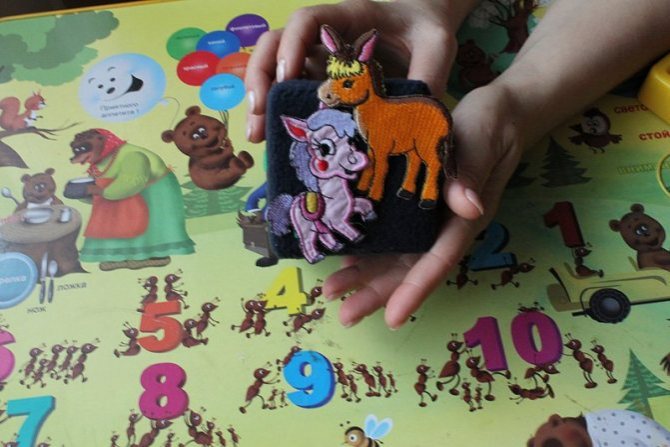
"Descriptive History"
The game is compiled using TRIZ technology in pedagogy.
Goal: Learn to write a narrative story using diagrams.
With the help of diagrams - images, we determine the selection of words of signs for the described object, the vocabulary is activated, the descriptive point in the story is specified and clarified. The game is played under the condition of a familiar subject and knowledge of the conventional patterns on the cards. The task of the game is to use any diagram that falls on the edge of the cube to choose a word or action for the object being described in order to compose a characteristic - a description according to any of the abandoned schemes. That is, whatever function falls out of it at the beginning and continues the description. Thus, a story can consist of at least six sentences. Another option is to create a riddle based on the description of the object.
Equipment: cube with pockets along the edges, images with TRIZ technology diagrams. [16]
"Dial-ka"
Objective: learn to write a story by moving images along the edges of a cube.
Task: compose a story or fairy tale based on the proposed images.
A soft cube with interchangeable images is used.
The Make It Cube teaches storytelling with creative elements based on images of an object. The manual suggests additional equipment: figurines of characters, domestic and wild animals, birds, made of fabric with Velcro. The cube itself is covered with fleece fabric. Each face of the cube serves as a support for the development of the plot. By turning the cube in any direction, the child chooses and adheres to the next aspect of the characters in the story or story. This guide can also be used for retelling or for selective retelling, where the edges of the character cube act as a visual outline [17]
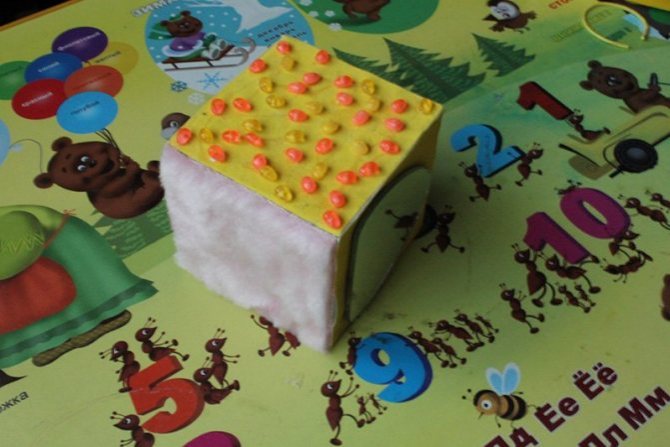
Bibliography:
1. Title: November 28, 2006: No. 6, Borisova E.A., Word games and exercises
2. F/l “Educator” n. 7 2009. Self-education. P. 104
3. F / l “Training manual for a senior teacher of a preschool institution” No. 1. 1 2010
4. Order of the Ministry of Education and Science of Russia
paragraph 655 of November 23, 2009
5. Lessons of frontal speech therapy in the preparatory group for children with phonetic and phonemic underdevelopment. V. V. Konovalenko V. S. Konovalenko I, II, III period. Fly. Publishing house “GNOMID”, 2005.
6. “Automation of sounds in game exercises” L.A. Komarov; Fly. Publishing house “GNOM”, 2011.
7. Speech therapy album. "We pronounce sounds correctly"
T.A. Tkachenko Ekaterinburg. Publishing house “Litur”, 2009.
8. “Training your fingers - developing your word!” O. I. Krupenchuk
Saint Petersburg. Publishing house "Litera", 2009.
9. We create an environment for developing the subject. Project “Speech Cube” p.54
10. “Speech therapy work to overcome violations of the syllabic structure of words in children” E.O. Astafieva St. Petersburg. Publishing house “Childhood-Press”, 2004
[1] 11.28.2006 Title: 2006 :: No. 6, Borisova E.A., Word games and exercises
[3] J/l “Educator” n. 7 2009. Self-education. P. 104
[4] Zh / l “Manual for a senior teacher of a preschool institution” No. 1. 1 2010
We create an environment for developing the subject. Project “Speech Cube” p.54
[5] Order of the Ministry of Education and Science of Russia No. 655 of November 23, 2009
app.docx (1.46 MB): [6] Fig.1, [7] Fig.2, [8] Fig.3, [9] Fig.4, [10] Fig.5, [11] Fig. 6, [12] Fig. 7, [13] Fig. 8, [14] Fig. 9, [16] Fig. 10,
Certificate of media release series A 0002220 SHPI 62502666132182 Shipment date 11/16/2013
We invite preschool teachers from the Tyumen region, the Yamalo-Nenets Autonomous Okrug and the Khanty-Mansiysk Autonomous Okrug-Ugra to publish their teaching materials: – teaching experience, original programs, teaching aids, class presentations, electronic games; – Actually developed notes and scenarios of educational events, projects, master classes (including videos), forms of work with families and teachers.
Why is it profitable to publish with us?
1. 1. “Tyumen Regional Nursery” is a specialized media outlet officially registered at the federal level. 2. Editorial activities are carried out with the support of the Department of Education and Science of the Tyumen Region 3. We issue a “Certificate of Publication” in the media. 4. The document has a unique number, is registered in the register, has the original seal of the Internet publication and a signature. 5. A “Certificate of Publication” in the media is sent to the author in both paper and electronic versions. More details More details >>> Example “Certificate of publication of author’s methodological material in the media” .pdf
Share this
The importance of didactic material in kindergarten
Didactic manuals serve as the basis for speech development classes. They create a storyline for the lesson, involving children in the game plot. This takes into account the concreteness and figurativeness of children's thinking. With their help, a fascinating game situation is created for the child to learn, where he is passionate and motivated to complete tasks.
The development of children's speech relies heavily on various didactic aids. Their diversity and the ability to make most of them with your own hands allows you to choose a suitable option for conducting classes with children.
Master class on making speech cubes.
Lyudmila Sergienko
Master class on creating voice cubes.
To make the process of automating sounds in words more fun and effective, to help turn the monotonous work of fixing sound pronunciation into an interesting game, I want to share the idea of creating vocal cubes.
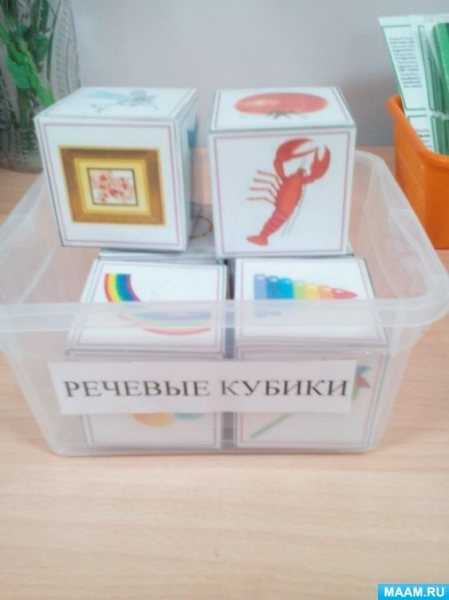
For work we will need: thick white or colored cardboard A4, ruler, pencil, glue, scissors, tape and pictures.
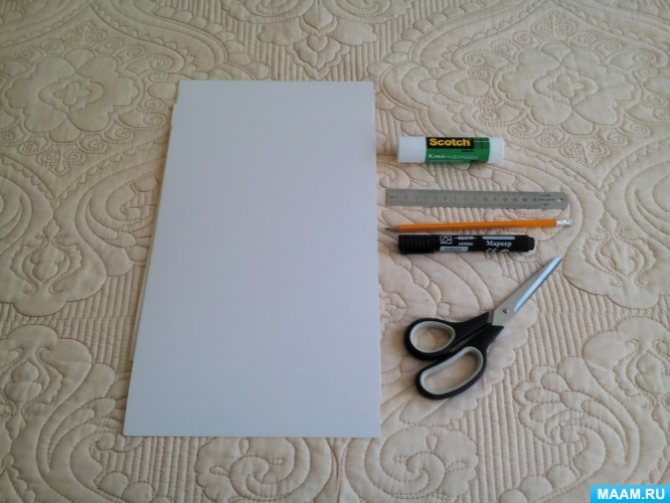
First you need to collect various images of the object. They can be cut out from children's magazines, drawn or printed on a color printer.
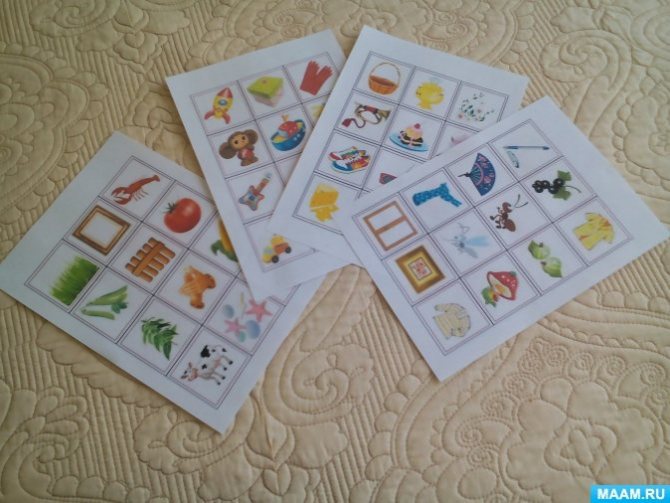
Draw a cube. I have it with sides of 6 cm (don’t forget to draw the flaps for gluing)
... Each line should be duplicated with a scissor blade for a neat fold, then glue all the cubes together.
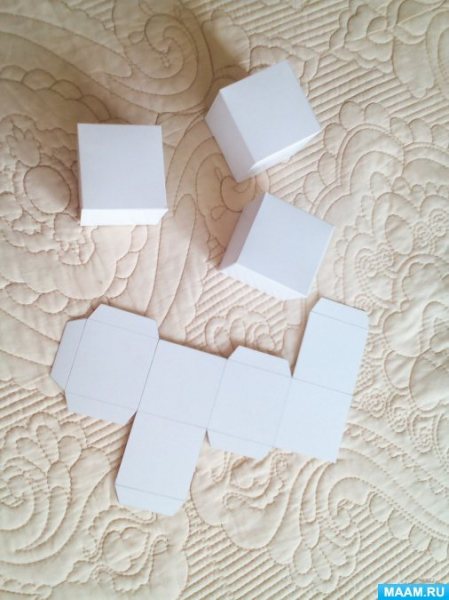
Insert one image on each side of the cube, meaning you need six images for each cube.
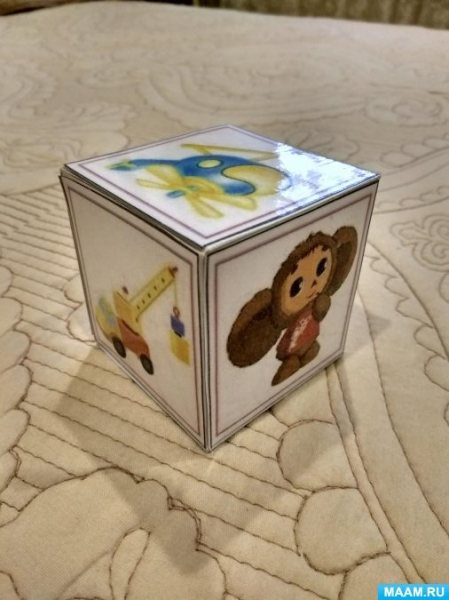
For more practical use of the cubes, it is advisable to “lamine” them on all sides with adhesive tape. These cubes are sure to last longer than usual.
Master class on how to make Valentine's Day Valentine's Day is a day of friendship and love. All the people exchange smiles and good wishes. All close friends, neighbors, relatives.
Master class for teachers “Logorhythmics as an effective method of overcoming speech disorders in preschool children” Master class for teachers: “Logorhythmics as an effective method of overcoming speech disorders in preschool children.” Goal: promotion.
Master class on the topic “Use of counting material from connected cubes in working with preschoolers” MDOO “Yagodka” kindergarten No. 6 of the Tutaevsky municipal district Prepared by: Zhuravleva.
Master class on creating a photo album Do-it-yourself gifts have many advantages over souvenirs bought in a store, their main advantage is exclusivity. Master class on creating a laptop Master class on creating a laptop “We live together” There are no children who don’t like being read to. The main thing is how to present it. Master class on creating a box Master class on creating a box. Goal: Use the chest as a surprise in class. When preparing a development lesson. Master class on making eco-feeders Cookies for birds
Master Class. Modern forms of work with young children to develop general language skills. The problem of language development remains one of the pressing topics, since communication is a necessary condition for the formation of personality and its consciousness.
Master class “Cultivating kindness and responsiveness, improving language skills in preschoolers” Summary of direct educational activities on the topic “Kind hands tell fairy tales” Educator: Maksimova.
Master class on making a horse. To make a horse we will need: colored paper, toilet paper rolls, wool threads, glue, scissors, a horse head pattern.
By the way: arm training by Alexander Fedorov
One source
DIY educational cube.
Flowers, ladybugs, bunnies, mice, buttons, fasteners - all this can be here.
The main requirement is safety during the game.
A large educational cube will help your child learn to walk on his feet:
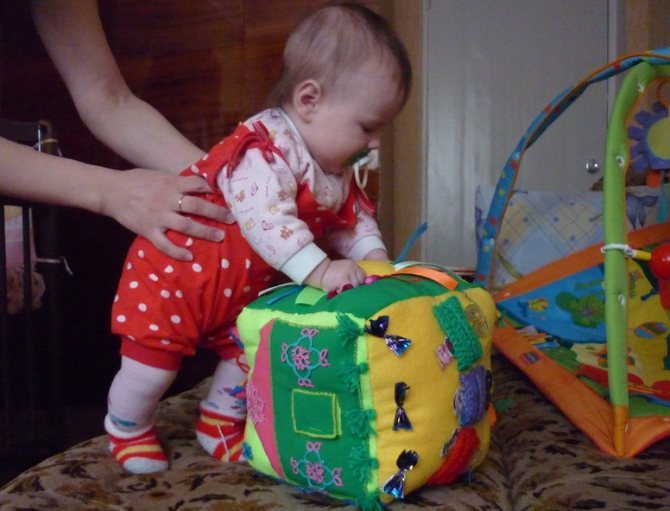
See how to create.
The simplest option is to take fabric, cut it into squares and sew according to the following pattern: For stuffing, you can use foam rubber, holofiber or cereal (rice, beans, peas):
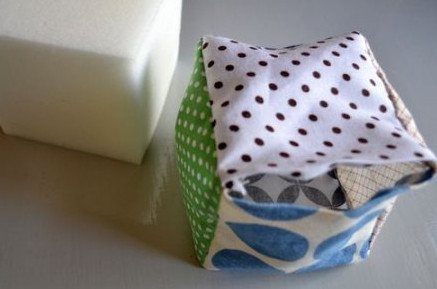
And when will you sew the next design?
